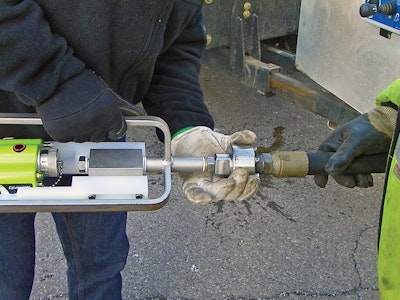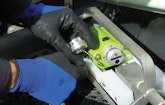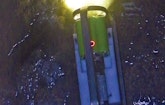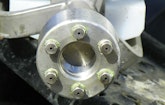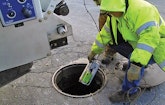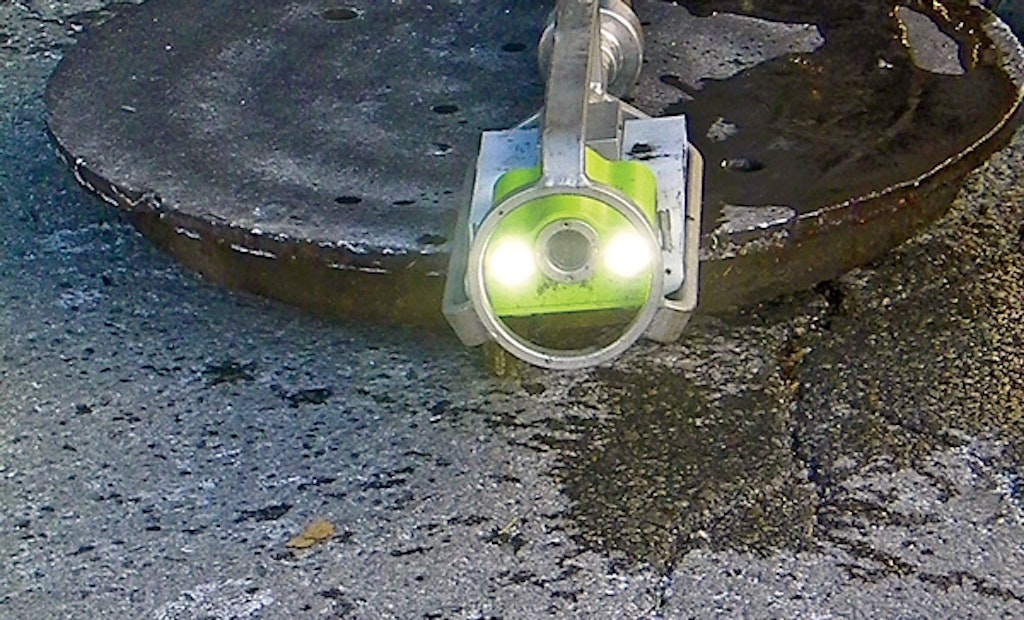
Interested in Cleaning?
Get Cleaning articles, news and videos right in your inbox! Sign up now.
Cleaning + Get AlertsSuccessfully jetting 2,500 to 3,500 linear feet of sewer line day-in and day-out requires focus, attention to detail and sound decision-making on a work site that prevents direct operator observation.
An experienced jetter operator can often reach informed conclusions from the debris he sees collecting in the manhole, but not always. Sometimes there is no substitute for seeing the work site firsthand. One option is to stop jetting and wait for a camera truck and support crew to arrive for a look down the line. Envirosight’s JetScan equips the jetter crew with an onboard alternative they carry to every work site.
Easily carried onboard a jetter truck, the JetScan does not need a sophisticated support truck or a second crew. The jetter operator can quickly deploy and retrieve a hi-def video capture device. The imagery, in turn, enables informed decision-making and a better overall line cleaning result.
On a windy late-November day with temperatures unexpectedly in the low teens, the JetScan was demonstrated in Beaver Falls, Pa. This small city — Joe Namath’s hometown — is about 40 miles northwest of Pittsburgh. Two Street Department crew members, Pat Burdine, an operator, and Bob Justisin, a helper, were asked to demonstrate the JetScan. Jake Wells, Envirosight’s marketing manager, and Jim Ahlborn, A&H Equipment’s territory manager, were also on hand. A&H is the local Envirosight dealer, and the company sold the city the Vactor the men used.
While somewhat unfamiliar with the JetScan, Burdine and Justisin had no difficulty mounting, deploying and retrieving it in a variety of municipal sewer lines. Ahlborn supplied the JetScan and Wells provided a laptop computer and an iPad to view the captured video.
Walk-around
The JetScan is a water-propelled and waterproof forward-looking digital video capture device mounted on a self-leveling stainless steel frame or sled. The “camera body” has two forward-facing LED lights mounted on either side of a fixed-focus lens with a 130-degree field of view. A single on/off button controls the camera’s operation. Video is saved to a standard SD card. The charging port for the internal battery, the SD card slot and a secondary camera-enable switch are grouped together. A waterproof screw-on cover engages the enable switch while covering the SD card and charging jack. The cap also creates a waterproof seal.
Without the cap fully secured, the device will not respond to the primary on/off button. This fail-safe feature assures that the device is never deployed in a less than waterproof configuration.
The basic sled system is designed for use in pipes from 8 to 15 inches in diameter. An available, albeit not shown, wheel set, when attached to the three sled runners, enables use in pipes ranging from 15 to 24 inches in diameter.
The JetScan is propelled forward by jetter-supplied high-pressure water delivered through a hose that connects to the sled via a 1-inch threaded male hose fitting. Water forced through as many as six rear-facing nozzles on the sled drives the entire system. The delivered force is sufficient to propel the JetScan to the full length of available hose. The jetter’s powered hose reel retrieves the extended hose with the JetScan firmly attached. An operative footage counter for the hose reel is essential.
The only user action needed to initiate or end video capture mode is to push the on/off button.
Operation
After the Vactor’s jetter hose reel was positioned over the entrance manhole and with work zone traffic control established, the jetter’s hose was screwed into the receiver on the back of the JetScan. Because of the receiver fitting’s palm-filling diameter, sufficient torque was developed and no hand tools were necessary to secure the JetScan to the hose.
The on button was pushed, and following a simple lights-on/device-on check, deployment began. Introducing the JetScan into the line to be inspected required no special skills or tools for this experienced jetting crew. As the water pressure was turned up, the sled began its travel through the line. The familiar unrestrained fine spray billowed from the open manhole, along with a quickly dissipating fog. The fog was caused by the interaction of the cold air being drawn over the warm water in the sewer line.
With no real-time imagery to watch, the image capture process continued in a traditional jetting mode. At the end of the run, customary retrieval practices came into play.
After retrieval, the JetScan was positioned on the ground while the jetter hose’s residual water bled off, illustrating the six streams that, underground and at much higher pressure, provide the propulsion. Burdine took care to position the discharging water jets in a direction that minimized the potential for bodily contact and injury.
When disconnected, the JetScan was placed on a handy truck step and turned off. There, Wells screwed off the waterproof cap and removed the SD card. He popped the card into an appropriate port on his laptop and after a quick data transfer, the video was available for review. The imagery was also ported to an iPad Mini, which Burdine and Justisin used to get a better look at what was encountered in the pipe.
The transferred data can be sent via email, FTP connection, copied to any storage device with adequate capacity and also archived on a hard drive or server.
Owner’s comments
Because of this crew’s limited experience with the JetScan, Steve Holzinger, an experienced maintenance technician in northern New Jersey, was contacted for firsthand user feedback. Holzinger works for the Franklin Township Sewerage Authority and has used the JetScan for about a year. “The JetScan has always met our needs,” he says. “We use it to verify our jetting work.” The township’s jetting program is intense, as every line is jetted annually. Holzinger’s crew cleans between 2,500 and 3,500 linear feet daily.
“We carry an iPad on the truck so we can watch the video as soon as the SD card is available,” says Holzinger. “The JetScan is handy. We have an aggressive program and we typically use it about three times a week,” he explained.
By keeping track of the readings on the footage counter, Holzinger is able to have a good idea of how far down the line the JetScan has traveled, should it encounter an impassable obstacle.
Back in Beaver Falls, Public Works Superintendent Bruno Gratteri is planning to add a JetScan to the city’s resources in “the very near future.”
Observer’s comments
The ease of one-button operation, the waterproof fail-safe cap and the simplicity of jetter hose to receiver connection puts mastery of the JetScan operation within every employee’s reach. High-definition imagery is obtained with low-tech simplicity.
The absence of a cleanup/disinfection protocol in the user’s manual is a significant omission, but municipalities usually determine their own hygiene protocols.
Manufacturer’s comments
“JetScan is an accessory no cleaning truck should be without,” says Envirosight’s Jake Wells. “It’s a quick, affordable way to understand pipe condition so you can pick the right nozzle, identify safety concerns and document the success of cleaning work.”
“Not meant to perform full inspections, the JetScan simply gathers footage of pipe conditions to make cleaning safer, faster and more effective.
“Saving the time and expense of calling in a TV truck makes the JetScan a real money saver,” Wells concludes.
